List of heads of state of the Soviet Union
| Politics of the Soviet Union |
|---|
|
The Constitution of the Soviet Union recognised the Presidium of the Supreme Soviet and the earlier Central Executive Committee (CEC) of the Congress of Soviets as the highest organs of state authority in the Union of Soviet Socialist Republics (USSR) between legislative sessions. Under the 1924, 1936 and 1977 Soviet Constitutions these bodies served as the collective head of state of the Soviet Union.[1] The Chairman of these bodies personally performed the largely ceremonial functions assigned to a single head of state[2] but was provided little real power by the constitution.
The Soviet Union was established in 1922. However, the country's first constitution was only adopted in 1924. Before that time, the 1918 Constitution of the Russian Soviet Federative Socialist Republic functioned as the constitution of the USSR. According to the 1918 Constitution, the All-Russian Central Executive Committee (CEC), whose chairman was head of state, had the power to determine what matters of income and taxation would go to the state budget and what would go to the local soviets. The CEC could also limit taxes.[3] In periods between convocations of the Congress of Soviets the CEC held supreme power.[4] In between sessions of the Congress of Soviets the CEC was responsible for all the affairs of the Congress of Soviets.[5] The CEC and the Congress of Soviets was replaced by the Presidium and the Supreme Soviet respectively by several amendments to the 1936 constitution in 1938.[6]
Under the 1977 Constitution of the Soviet Union, the Supreme Soviet was the highest organ of state power and the sole organ in the country to hold legislative authority.[6] Sessions of the Supreme Soviet were convened by the Presidium twice a year; however, special sessions could be convened on the orders of a Union Republic.[6] In the event of a disagreement between the Soviet of the Union and the Soviet of Nationalities the Presidium could form a conciliation commission. If this commission failed, the Presidium could dissolve the Supreme Soviet and order new elections.[6] The Chairman of the Presidium of the Supreme Soviet, along with the first and fifteen other vice chairmen, would be elected by the deputies of the Supreme Soviet.[7] In practice, the Chairman of the Presidium held little influence over policy ever since the delegation of the office's power to the General Secretary of the Communist Party of the Soviet Union (CPSU) during Joseph Stalin's rule.[8]
The Presidency was established in 1990 and the President would, according to the altered constitution, be elected by the Soviet people by direct and secret ballot. However, the first and only Soviet President, Mikhail Gorbachev, was elected by the democratically elected Congress of People's Deputies.[9] In connection with the dissolution of the Soviet Union national elections for the office of President never took place. To be elected to the office a person must have been a Soviet citizen and older than thirty-five but younger than sixty-five years. The same person could not be elected president more than twice.[10] The Presidency was the highest state office, and was the most important office in the Soviet Union by influence and recognition, eclipsing that of Premier (later renamed to Prime Minister) and General Secretary. With the establishment of the Presidency executive power was shared between the President and the Prime Minister. The President was given broad powers, such as being responsible for negotiating the membership of the Cabinet of Ministers with the Supreme Soviet;[11] the Prime Minister, however, was responsible for managing the nomenklatura and economic matters.[12]
List of heads of state[]
Of the eleven individuals appointed head of state, three died in office of natural causes (Leonid Brezhnev, Yuri Andropov and Konstantin Chernenko), one held the position in a temporary role (Vasili Kuznetsov), and four held posts of party leader and head of state simultaneously (Brezhnev, Andropov, Chernenko and Mikhail Gorbachev). The first head of state was Mikhail Kalinin, who was inaugurated in 1922 after the Treaty on the Creation of the USSR. At over twenty years, Kalinin spent the longest time in office; he died shortly after his resignation in 1946. Andropov spent the shortest time in office.
Heads of the Russian Soviet Republic (1917–1922)[]
| No. | Portrait | Name (Born-Died) |
Term of office | ||
|---|---|---|---|---|---|
| Took office | Left office | Time in office | |||
| Chairmen of the Central Executive Committee of the All-Russian Congress of Soviets (1917–1938) | |||||
| 1 | 
|
Lev Kamenev (1883–1936) |
9 November 1917 | 21 November 1917 | 12 days |
| 2 | 
|
Yakov Sverdlov (1885–1919) |
21 November 1917 | 16 March 1919 † | 1 year, 115 days |
| – | 
|
Mikhail Vladimirsky (1874–1951) Acting |
16 March 1919 | 30 March 1919 | 14 days |
| 3 | 
|
Mikhail Kalinin (1875–1946) |
30 March 1919 | 30 December 1922 | 3 years, 275 days |
Heads of the Soviet Union (1922–1991)[]
| No. [note 1] |
Name (Birth–Death) |
Portrait | Term of office | Supreme Soviet Convocations [note 2] |
|---|---|---|---|---|
| 1 | Chairman of the Central Executive Committee of the Congress of Soviets (1922–1938) | |||
| Mikhail Kalinin (1875–1946)[13] |
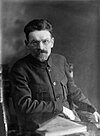
|
30 December 1922 – 12 January 1938 | 1st–8th Convocation | |
| Chairman of the Presidium of the Supreme Soviet (1938–1989) | ||||
| Mikhail Kalinin (1875–1946)[13] |

|
17 January 1938 – 19 March 1946 | 1st Convocation | |
| 2 | Nikolay Shvernik (1888–1970)[14] |
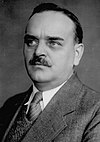
|
19 March 1946 – 15 March 1953 | – |
| 3 | Kliment Voroshilov (1881–1969)[15] |
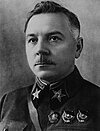
|
15 March 1953 – 7 May 1960 | – |
| 4 | Leonid Brezhnev (1906–1982)[16] |

|
7 May 1960 – 15 July 1964 | – |
| 5 | Anastas Mikoyan (1895–1978)[17] |

|
15 July 1964 – 9 December 1965 | |
| 6 | Nikolai Podgorny (1903–1983)[18] |
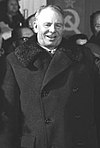
|
9 December 1965 – 16 June 1977 | – |
| (4) | Leonid Brezhnev (1906–1982)[16] |

|
16 June 1977 – 10 November 1982 | – |
| — | Vasili Kuznetsov (1901–1990)[19] |

|
10 November 1982 – 16 June 1983 | |
| 7 | Yuri Andropov (1914–1984)[20] |

|
16 June 1983 – 9 February 1984 | |
| — | Vasili Kuznetsov (1901–1990)[19] |

|
9 February 1984 – 11 April 1984 | |
| 8 | Konstantin Chernenko (1911–1985)[20] |

|
11 April 1984 – 10 March 1985 | |
| — | Vasili Kuznetsov (1901–1990)[19] |

|
10 March 1985 – 27 July 1985 | |
| 9 | Andrei Gromyko (1909–1989)[21] |

|
27 July 1985 – 1 October 1988 | |
| 10 | Mikhail Gorbachev (born 1931)[22] |
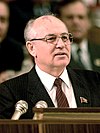
|
1 October 1988 – 25 May 1989 | – |
| Chairman of the Supreme Soviet (1989–1990)[note 3] | ||||
| Mikhail Gorbachev (born 1931)[22] |

|
25 May 1989 – 15 March 1990 | ||
| President of the Soviet Union (1990–1991) | ||||
| Mikhail Gorbachev (born 1931)[22] |

|
15 March 1990 – 25 December 1991 | ||
List of vice heads of state[]
There have been four individuals appointed vice head of state. At over eight years, Vasily Kuznetsov spent the longest time in office. Gennady Yanayev spent the shortest time in office.
| No. [note 1] |
Name (Birth–Death) |
Portrait | Term of office | Convocations [note 2] |
|---|---|---|---|---|
| First Vice Chairman of the Presidium of the Supreme Soviet (1977–1989) | ||||
| 1 | Vasili Kuznetsov (1901–1990)[19] |

|
7 October 1977 – 18 June 1986 | – |
| 2 | Pyotr Demichev (1917–2010)[24] |
18 June 1986 – 1 October 1988 | ||
| 3 | Anatoly Lukyanov (1930–2019)[25] |

|
1 October 1988 – 25 May 1989 | – |
| Vice Chairman of the Supreme Soviet (1989–1990) | ||||
| Anatoly Lukyanov (1930–2019)[25] |

|
25 May 1989 – 15 March 1990 | ||
| Vice President of the Soviet Union (1990–1991) | ||||
| 4 | Gennady Yanayev (1937–2010)[26] |
27 December 1990 – 21 August 1991[note 4] | ||
| — | Office abolished[28] | 21 August 1991 – 26 December 1991[note 5] | ||
List of general secretaries of the CPSU[]
| Name (Birth–Death) |
Portrait | Term of office | Notes |
|---|---|---|---|
| General Secretary of the Central Committee of the All-Union Communist Party (Bolsheviks) (1922–1952) | |||
| Joseph Stalin (1878–1953)[29] |

|
3 April 1922 – 16 October 1952 | Stalin used the office of General Secretary to create a strong power base for himself. At the 17th Party Congress in 1934, Stalin was not formally re-elected as General Secretary[30] and the office was rarely mentioned after that[31] but Stalin retained his positions and all of his power. The office was formally abolished at the 19th Party Congress on 16 October 1952, but Stalin retained ultimate power.[32] At 30 years 7 months, Stalin was by far the longest-serving General Secretary, serving for almost half of the USSR's entire existence. |
| First Secretary of the Central Committee of the Communist Party of the Soviet Union (1953–1966) | |||
| Nikita Khrushchev (1894–1971)[33] |

|
14 September 1953 – 14 October 1964 | Khrushchev reestablished the office on 14 September 1953 under the name First Secretary. In 1957 he was nearly removed from office by the Anti-Party Group. Georgy Malenkov, a leading member of the Anti-Party Group, worried that the powers of the First Secretary were virtually unlimited.[34] Khrushchev was removed as leader on 14 October 1964, and replaced by Leonid Brezhnev.[35] |
| Leonid Brezhnev (1906–1982) [36] |

|
14 October 1964 – 8 April 1966 | Brezhnev was part of a collective leadership with Premier Alexei Kosygin and others.[37] The office of First Secretary was renamed General Secretary at the 23rd Party Congress.[38] |
| General Secretary of the Central Committee of the Communist Party of the Soviet Union (1966–1991) | |||
| Leonid Brezhnev (1906–1982) [36] |

|
8 April 1966 – 10 November 1982 | Brezhnev's powers and functions as the General Secretary were limited by the collective leadership.[39] By the 1970s Brezhnev's influence exceeded that of Kosygin as he was able to retain this support by avoiding any radical reforms. |
| Yuri Andropov (1914–1984)[40] |

|
12 November 1982 – 9 February 1984 | He emerged as Brezhnev's most likely successor as the chairman of the committee in charge of managing Brezhnev's funeral.[41] Andropov ruled the country in the same way Brezhnev had before he died.[42] |
| Konstantin Chernenko (1911–1985)[36] |

|
13 February 1984 – 10 March 1985 | Chernenko was 72 years old when elected to the post of General Secretary and in rapidly failing health.[43] Like Andropov, Chernenko ruled the country in the same way Brezhnev had.[42] |
| Mikhail Gorbachev (born 1931)[44] |

|
11 March 1985 – 24 August 1991 | The 1990 Congress of People's Deputies removed Article 6 from the 1977 Soviet Constitution. Thus, the Communist Party lost its position as the "leading and guiding force of the Soviet society" and the powers of the General Secretary were drastically curtailed. Throughout the rest of his tenure Gorbachev ruled through the office of President of the Soviet Union.[45] He resigned from his party office on 24 August 1991 in the aftermath of the August Coup.[46] |
| Vladimir Ivashko (1932–1994)[47] |
24 August 1991 – 29 August 1991 | He was elected Deputy General Secretary at the 28th Party Congress. Ivashko became acting General Secretary following Gorbachev's resignation, but by then the Party was politically impotent and on 29 August 1991, it was banned.[48] | |
See also[]
- Soviet Union-related
- Presidium of the Supreme Soviet
- Supreme Soviet of the Soviet Union
- List of leaders of the Soviet Union
- Premier of the Soviet Union
- List of governments of the Soviet Union
- List of spouses of the heads of state of the Soviet Union
- General Secretary of the Communist Party of the Soviet Union
- Russia-related
- List of leaders of the Russian SFSR
- List of heads of government of Russia
- List of presidents of the Russian Federation
Notes[]
- ^ Jump up to: a b Repeat head of state and vice heads of state are numbered only once; subsequent terms are marked with their original number italicised. Acting heads of state are not numbered. These numbers are not official.
- ^ Jump up to: a b A convocation in the Soviet sense of the word were elected members of Parliament in between elections.
- ^ On 15 March 1990 most constitutional powers were transferred to the newly created office of President of the Soviet Union. Anatoly Lukyanov was elected Chairman of the Supreme Soviet to replace Mikhail Gorbachev. Although the Chairman's office retained its name, it was now that of a parliamentary speaker, not a head of state. Real executive powers were retained by Gorbachev.[23]
- ^ Yanayev was Acting President of the Soviet Union during the August Coup of 1991, but was jailed following the coup's collapse and Gorbachev returned to his post as President.[27]
- ^ Following the failed August Coup of 1991 the State Council was given the power to elect a Vice President in the temporary absence of the President.[28]
References[]
- ^ Armstrong, John Alexander (January 1, 1978). Ideology, Politics, and Government in the Soviet Union: An Introduction– Google Knihy. ISBN 9780819154057. Retrieved 2016-11-26.
- ^ Isham, Heyward (1995). Remaking Russia. M.E. Sharpe. p. 218. ISBN 978-1-56324-436-0.
- ^ Всероссийский съезд Советов. Статья №81 от 10 июля 1918 г. «Бюджетное право». (All-Russian Congress of Soviets. Article #81 of 10 July 1918 The Budget. ).
- ^ Всероссийский съезд Советов. Статья №30 от 10 июля 1918 г. «О Всероссийском съезде Советов рабочих, крестьянских, казачьих и красноармейских депутатов». (All-Russian Congress of Soviets. Article #30 of 10 July 1918 The All-Russian Congress of Soviets of Workers', Peasants', Cossacks', and Red Army Deputies. ).
- ^ Всероссийский съезд Советов. Статья №29 от 10 июля 1918 г. «О Всероссийском съезде Советов рабочих, крестьянских, казачьих и красноармейских депутатов». (All-Russian Congress of Soviets. Article #29 of 10 July 1918 The All-Russian Congress of Soviets of Workers', Peasants', Cossacks', and Red Army Deputies. ).
- ^ Jump up to: a b c d Съезд Советов СССР. Статья №30–56 от 10 июля1918 г. «Высшие органы государственной власти Союза Советских Социалистических Республик». (Congress of Soviets of the Soviet Union. Article #30–56 of 10 July 1918 The Highest Organs of State Authority of The Union of Soviet Socialist Republics. ).
- ^ Верховный Совет СССР. Статья №120 от 7 октября 1977 г. «Верховный Совет СССР». (Supreme Soviet of the Soviet Union. Article #120 The Supreme Soviet of the USSR. ).
- ^ Service, Robert (2005). Stalin: A Biography. Harvard University Press. p. 363. ISBN 978-0-674-01697-2.
- ^ Kort, Michael (2010). The Soviet Colossus: History and Aftermath. M.E. Sharpe. p. 394. ISBN 978-0-7656-2387-4.
- ^ Верховный Совет СССР. Статья №127.1 от 26 декабря 1990 г. «Президент СССР». (Supreme Soviet of the Soviet Union. Article #127.1 of 26 December 1990 President of the USSR. ).
- ^ Huskey, Eugene (1992). Executive Power and Soviet Politics: The Rise and Decline of the Soviet State. M.E. Sharpe. p. 90. ISBN 978-1-56324-059-1.
- ^ Huskey, Eugene (1999). Presidential Power in Russia. M.E. Sharpe. p. 16. ISBN 978-1-56324-536-7.
- ^ Jump up to: a b Shepilov, Dmitri; Austin, Anthony; Bittner, Stephen (2007). The Kremlin's Scholar: A Memoir of Soviet Politics under Stalin and Khrushchev. Yale University Press. p. 413. ISBN 978-0-300-09206-6.
- ^ Shepilov, Dmitri; Austin, Anthony; Bittner, Stephen (2007). The Kremlin's Scholar: A Memoir of Soviet Politics under Stalin and Khrushchev. Yale University Press. p. 441. ISBN 978-0-300-09206-6.
- ^ Shepilov, Dmitri; Austin, Anthony; Bittner, Stephen (2007). The Kremlin's Scholar: A Memoir of Soviet Politics under Stalin and Khrushchev. Yale University Press. p. 406. ISBN 978-0-300-09206-6.
- ^ Jump up to: a b Bliss Eaton, Katherine (2004). Daily Life in the Soviet Union. Greenwood Publishing Group. p. 29. ISBN 978-0-313-31628-9.
- ^ Shepilov, Dmitri; Austin, Anthony; Bittner, Stephen (2007). The Kremlin's Scholar: A Memoir of Soviet Politics under Stalin and Khrushchev. Yale University Press. p. 404. ISBN 978-0-300-09206-6.
- ^ Ploss, Sidney (2010). The Roots of Perestroika: the Soviet Breakdown in Historical Context. McFarland & Company. p. 218. ISBN 978-0-7864-4486-1.
- ^ Jump up to: a b c d Кузнецов Василий Васильевич [Vasili Vasilyevich Kuznetsov] (in Russian). World History on the Internet. Retrieved 7 December 2010.
- ^ Jump up to: a b Ploss, Sidney (2010). The Roots of Perestroika: the Soviet Breakdown in Historical Context. McFarland & Company. p. 216. ISBN 978-0-7864-4486-1.
- ^ Ploss, Sidney (2010). The Roots of Perestroika: the Soviet Breakdown in Historical Context. McFarland & Company. p. 217. ISBN 978-0-7864-4486-1.
- ^ Jump up to: a b c Bliss Eaton, Katherine (2004). Daily Life in the Soviet Union. Greenwood Publishing Group. p. 32. ISBN 978-0-313-31628-9.
- ^ Anderson, John (1994). Religion, state, and politics in the Soviet Union and successor states. Cambridge University Press. p. 188. ISBN 978-0-521-46784-1.
- ^ Петр Демичев : Умер министр культуры СССР Петр Демичев [The Minister of Culture of the USSR Pyotr Demichev dies] (in Russian). Peoples.ru (Lenta.Ru). Archived from the original on 16 July 2011. Retrieved 8 December 2010.
- ^ Jump up to: a b Evtuhov, Catherine; Stites, Richard (2004). A History of Russia: Peoples, Legends, Events, Forces since 1800. Houghton Mifflin Harcourt. p. 474. ISBN 978-0-395-66073-7.
- ^ Schwirz, Michael (24 September 2010). "Gennadi I. Yanayev, 73, Soviet Coup Plotter, Dies". The New York Times. Retrieved 8 December 2010.
- ^ Staff writer (10 February 2011). "Soviet Coup Leader Gennady Yanayev Dies". BBC Online. Retrieved 8 December 2010.
- ^ Jump up to: a b Government of the USSR: Gorbachev, Mikhail (5 September 1991). Закон "Об органах государственной власти и управления Союза ССР в переходный период" [Law: On the bodies of State Authority and Administration of the USSR in the Period of Transition] (in Russian). Soyuz Sovietskikh Sotsialisticheskikh Respublik. Retrieved 13 February 2011.
- ^ Brown 2009, p. 59.
- ^ Rappaport 1999, pp. 95–96.
- ^ Ulam 2007, p. 734.
- ^ Brown 2009, pp. 231–232.
- ^ Taubman 2003, p. 258.
- ^ Ra'anan 2006, p. 69.
- ^ Service 2009, p. 378.
- ^ Jump up to: a b c Chubarov 2003, p. 60.
- ^ Brown 2009, p. 403.
- ^ McCauley 1997, p. 48.
- ^ Baylis 1989, pp. 98–99 & 104.
- ^ Vasil'eva 1994, pp. 218.
- ^ White 2000, p. 211.
- ^ Jump up to: a b Baylis 1989, p. 98.
- ^ Service 2009, pp. 433–435.
- ^ Service 2009, p. 435.
- ^ Kort 2010, p. 394.
- ^ Radetsky 2007, p. 219.
- ^ McCauley 1998, p. 314.
- ^ McCauley 1997, p. 105.
- Lists of political office-holders in Russia
- Lists of political office-holders in the Soviet Union
- Heads of state of the Soviet Union
- Government of the Soviet Union
- Lists of heads of state